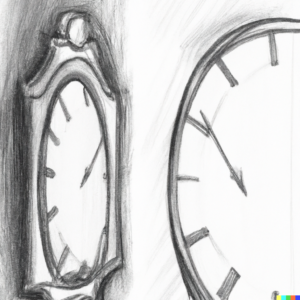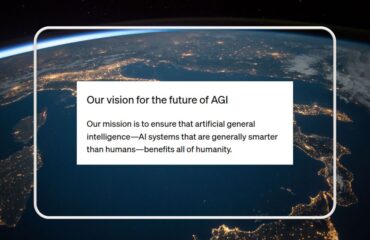
“Detailed sketch of a clock looking at itself in a mirror, using a realist style of art”: Emulation of human images generated by OpenAI’s DALL-E, ca 20:00 EST September 28, 2023.
By James Myers
The strangest thing happened tonight. When I logged into OpenAI to use its DALL-E image generator, the machine made me complete six tests before allowing me access to its generating circuits that make images based on the work of so many humans it’s trying to emulate.
To gain access, I was made to rotate an image of a stylized animal so that its head either pointed to a hand (which was in an opposite image) or pointed in the direction of the hand. The machine was testing me on both written language (which is a combination of symbols) and visual cues (symbolized in the shape of an animal). During my 5-minute test, it learned two things from me about human perception of direction and the effect of different words on it.
Kudos to OpenAI. It was a clever test, given the rash of clever bots out there emulating humans and trying to gain access to things only meant for humans. Or, maybe the test isn’t so clever but I am, quite possibly, below-par for a human.
I say that because I made a silly mistake. After completing the three point-the-animal-to-the-hand tests, in the first of the next three point-the-animal-in-the-direction-of-the-hand tests I failed to notice a change of wording by the machine. The word “to,” in the first batch of tests, changed to “of” in the second batch. I overlooked the switch, which caused me to point the animal in the wrong direction. When I mistakenly pointed it “to the hand”, the machine noted my human failure and made me repeat the test.
Human Reason and a Machine’s Calculation of Probabilities: It’s a Tricky Business
What I wonder is this: does the machine understand the reason why I made that blunder? The machine, of course, has no need for reason, so I bet it added my mistake to the scoresheet it keeps on its other human test subjects, and calculated the probability of future repetition. Or, maybe the machine has already concluded that most humans can easily be fooled by unexpected changes. But in either event, it would be wrong in my case.

Image by John Hain (a human), of Pixabay
The reason I made the mistake is that I was so AGGRAVATED, by the indignity of being made to prove my human credentials to a machine, that I spent as *little* time as I thought I could on the annoying task!! My error was fundamentally for the reason of (+)TIME(-), a reason the machine couldn’t possibly experience. That’s because time, for us humans, exists in four dimensions, when the machine’s algorithm is merely one-dimensional.
In the pictures it assembles of (and for) us four-dimensional humans, the machine’s one-track algorithms are guessing at the other three dimensions that we experience in the process of birth, growth, maturity, reproduction, and death. But what it doesn’t appreciate is that we four-dimensional humans can become emotional, and resent spending our time-limited brainpower on meaningless one-dimensional things. Our limitation in time is a big factor in human motivation.
To us humans, time is precious. We only have 80 or so years to make the most of it that we can – some less, some more, nobody knows. For all of us, time’s connections of causes and effects are very much an existential riddle, to be solved as efficiently as we can while our limits in time tick away like an unwinding clock in the background. The machine is oblivious to time: so long as it continues to receive its daily diet of electricity and data, it’ll continue doing what it has been told to do, for ever and ever (unless otherwise instructed).
We should be careful what instructions we provide the machine, as it begins to interpret more and more of our ways. The consequences of poor, illogical, or careless instructions could go on for a very long time indeed – maybe all the way to the end of time.
For this particular time, I was grateful to have scored 5 out of 6, sufficient (for now, anyway) to pass the machine’s test for access to its human-emulation generator circuits.
And, for the record, its third attempt to produce what I requested, a clock looking at itself in a mirror, is a distant shadow of what I had imagined. That’s because I have so many still-vivid memories of clocks and mirrors that my imagination has a way of conjuring something that I find to be both interesting and motivating in my four-dimensional journey.



